Unification Thought
Chapter 11: Methodology
Methodology is the study of how one can reach the objective truth. In fact, the English word method is derived from the Greek word meta (following) and hodos (the way). Thus, "method" implies that in order to attain some purpose, one should follow a certain way.
From the time of ancient Greece until today, many philosophers have developed their own unique methodologies. Here we will first take up representative traditional methodologies, and will present the methodology of Unification Thought, that is Unification Methodology. Next, we will examine the traditional methodologies from the standpoint of Unification Thought.
I. Historical Review
In this section, a brief outline will be presented of the major methodologies in the history of philosophy.
First, we will deal with methodologies in the ancient period; and second, we will deal with methodologies in the modern period, including contemporary methodologies.
A. Methodologies in the Ancient Period
1. Heraclitus' Dialectic -- A Dynamic Method
Heraclitus (ca. 535-475 BC), was considered by Hegel to be the founder of the dialectic. Heraclitus considered the fundamental matter of the universe to be fire and regarded fire as constantly changing.
Stating that "everything is in a state of flux," he held that nothing is eternal; rather, everything is in the state of generation and movement. Further stating that "war is the father and the king of all," he considered everything to be generating and changing through the conflict of opposites. Yet, he held there is something unchangeable in generation and change, namely, law, which he called Logos. Also, he held that in all things, harmony arises through conflict. The methodology of Heraclitus deals with the way nature is, and with the development of nature. His dialectic, which seeks to grasp the dynamic aspect of things in this way, could be called a dynamic method.
2. Zeno's Dialectic -- A Static Method
Contrary to Heraclitus, who asserted that everything is in a state of flux, Parmenides (ca. 510 BC) of the Eleatic school held that there is no generation or destruction, there is no motion or change.
Inheriting Parmenide's thought, Zeno of Elea (ca. 490-430 BC) denied movement, and tried to prove that there is only one motionless being.
Zeno alleged four proofs for the view that material bodies, though appearing to be moving, are, in fact, not moving at all. One of his proofs is that Achilles cannot ever overtake a tortoise. Achilles is a hero who distinguished himself during the Trojan War. Though a very fast runner, still he could not overtake a tortoise, Zeno maintained. Suppose the tortoise starts first; After the tortoise has advanced to a certain point, Achilles starts running after it. When Achilles arrives at the place where the tortoise was when he started, the tortoise has already gone ahead a certain distance. When Achilles arrives at that next place, the tortoise has already advanced again by a certain distance. Consequently, the tortoise is always ahead of Achilles.
Another proof offered by Zeno was that a flying arrow is always at rest. Suppose an arrow is flying from point A toward point C. At a certain moment, die arrow passes through point B, which is between A and C.
To pass through point B means to stop at that point for a moment. However, since the distance between A and C is a continuum of an innumerable number of points, the arrow is continuously at rest. Therefore, the arrow is always at rest.
Zeno's method is the art of dispute through question and answer, whereby one refutes his opponent by exposing contradictions in him, while examining his assertions. Aristotle called him the founder of the dialectic. Zeno's dialectic, which denied movement and proved that there is only one motionless being, could be called the static method.
3. Socrates' Dialectic -- A Method of Dialogue
In the latter half of the 5th century BC, democratic politics was developed in Athens. During that time, young people made efforts to learn the art of persuasion in order to succeed in politics. Therefore, there appeared professionals who specialize in teaching young people the art of persuasion. They were called sophists.
Early Greek philosophy dealt with nature as its object; but the sophists turned away from the philosophy of nature to discuss human problems. They came to realize, however, that, while nature has objectivity and necessity, human matters are relative; as a result, those who gave up the solution of human problems came to have skepticism and relativism. Some even asserted that no truth exists at all with regard to human being. As a result, the art of persuasion that they taught attached importance only to the method of how to refute one's opponents, and came to use even sophistry for that purpose.
Socrates (470-399 BC) deplored the fact that sophists were confusing the people in that way and asserted that what is important is the virtue with which one should live, rather than the technical knowledge for political success. For him, only true knowledge can show what virtue is. He held that, in order to attain truth, what is necessary, first of all, is to know one's own ignorance, and stated, "Know thyself." Also, he considered that one can reach the truth by engaging in dialogue with another person with a humble heart.
Then, starting from the particular, we are led to the universal conclusion.
To reach the truth is to evoke the truth dormant in the mind of the person through asking questions, and to bring forth the truth from the person's mind. Socrates named this process midwifery. Socrates' method of pursuing the truth is called die dialectic, or the method of discussion.
4. Plato's Dialectic -- A Method of Division
Plato (427-347 BC), a disciple of Socrates, tried to explain how true knowledge concerning the virtue referred to by Socrates comes to be obtained. Plato maintained the existence of non-material being that is the essence of thing, and he called it Idea, or Form (eidos). Among scores of Ideas, he regarded the Idea of the Good as supreme, and asserted that only when people intuit the Idea of the Good, can they lead the supreme life.
According to Plato, that which truly exists is the Idea, and the phenomenal world is nothing but the copies of the world of Ideas. Accordingly, knowledge of the Ideas is indeed true knowledge. He called his method of cognition of Ideas the dialectic.
Plato's dialectic sought to determine the relationships between ideas and to explicate the structure of Ideas, which placed the Idea of the Good at the apex. In the cognition of Ideas, there are two directions: The first progresses from the upper to the lower through the division of the generic concepts into specific concepts; the second progresses from the lower to the upper through synthesizing the concepts of individual things, aiming at the supreme concept. Among the two methods, the direction of synthesis corresponds to Socrates' dialectic; the direction of division is most typically Plato's. Thus, when we refer to Plato's dialectic, we usually mean the method of division. In contrast to Socrates, who considered that knowledge could be obtained through a dialogue between person and person, Plato proposed his dialectic as a method of classifying concepts, or a method of self-questioning and self-answering, namely, a method of question and answer in one's mind.
5. Aristotle's Deductive Method
The study of how correct knowledge can be obtained was systematized by Aristotle (384-322 BC) as the science of knowledge, that is, logic. Logic, which was compiled in the Organon, was regarded as an instrument for reaching truth through proper thinking, as a science preliminary to the various other sciences.
According to Aristotle, true knowledge should be obtained through logical proof. He recognized the inductive method as well, in which one proceeds from the particular to the universal; but Aristotle regarded it as less than perfect. He thought that the deductive method, in which the particulars are deduced from the universal, would provide surer knowledge. The fundamental tool of this method is the syllogism. A representative example of a syllogism is as follows:
In the Middle Ages, great importance was attached to Aristotle's logic as an instrument for proving the propositions of theology and philosophy deductively. The Aristotelian syllogism was recognized for about two thousand years, hardly undergoing any change.
B. Methodologies in the Modern Period
1. Bacon's Inductive Method
Throughout the Middle Ages, God was regarded as transcendental, but during the period of the Renaissance, the perception of the transcendental character of God was gradually lost among philosophers.
There arose a pantheistic philosophy of nature, which regarded God as inherent in nature. Furthermore, philosophy became a methodology of studying nature. Its representative exponent was Francis Bacon (1561-1626).
According to Bacon, previous studies which were based on metaphysics, were "sterile and like a virgin consecrated to God, produces nothing," mainly because it employed Aristotle's method.
Aristotle's logic was a method for the sake of logical proof. With such logic, one might persuade others.
With it, however, one could not obtain truths from nature. Thus, Bacon advocated the inductive method as the logic for finding new truth. He named his own discourse on logic New Organan, as opposed to Aristotle's Organon.
Asserting that traditional studies had been nothing but logical arguments, based on totally useless words, Bacon held that, in order to obtain sure knowledge, we must first eliminate those prejudices to which we are liable, and then explore nature itself directly. Those prejudices are the Four Idols (see "Epistemology").
After eliminating these Idols, we observe nature and make experiment on nature, and from there, we find the universal essences existing within individual phenomena.
Traditional inductive methods had sought to obtain general laws from a small number of observation and experiment; Bacon, however, tried to present a true inductive method in order to obtain sure knowledge by collecting as many cases as possible, and also by attaching importance to negative instances.
2. Descartes's Methodic Doubt
Due to the remarkable achievements made in natural sciences since the Renaissance period, 17th century philosophy regarded the mechanistic view of nature as the absolute truth, and tried not to contradict it. Rationalism tried to provide a foundation for the mechanistic view of nature from a more fundamental standpoint. Its representative exponent was Rene Descartes (1596-1650).
Descartes considered the mathematical method to be the only true method; thus, as in mathematics, he first looked for an intuitive truth that was obvious to everyone, and then based upon it, he sought to develop a new, sure truth deductively.
Thus, there arose a question in how to seek an intuitive truth that could become the starting point of philosophy. Descartes's method was to doubt as much as he could in order to pursue an absolutely reliable truth, which could then become the principle for all knowledge. Even though he doubted everything, however, the fact that he, who doubted, existed could not be doubted, he noticed. He expressed that in the famous proposition, "I think, therefore I am" (cogito ergo sum). Next, he asked why that proposition was certain without any proof, and he answered that it was because that proposition was clear and distinct. From that point he derived a general rule that "things we conceive very clearly and very distinctly are all true." Cartesian doubt is not for the sake of doubt, but for the sake of discovering truth. It is called methodic doubt. Descartes tried to obtain sure knowledge by following the mathematical method, in which one starts with axioms that can be intuited clearly and distinctly and proves various propositions.
3. Hume's Empiricism
Contrary to rationalism, represented by Descartes, empiricism, developed centering on Britain, took the position of explaining spiritual things on the basis of natural laws discovered empirically.
In order to find a complete system of sciences, David Hume (1711-1776) analyzed the mental processes of the human mind objectively with a new method of finding truth. Through the search for the unchanging, natural laws in human mind, Hume tried to clarify the foundation of all the sciences, where the human mind is involved.
Hume analyzed the ideas, which are the elements of the human mind. According to Hume, when simple ideas are associated with each other, there are three principles of association: resemblance, contiguity in time and space, and cause and effect. Among these three, lie held that the resemblance of ideas and the contiguity of ideas are sure knowledge, while the cause and effect is merely subjective belief.
As a result, Hume's empiricism fell into skepticism, which asserted that objective knowledge cannot be obtained even through inductive inference based on experience and observation. He came to deny all forms of metaphysics and regarded even natural sciences as insecure.
4. Kant's Transcendental Method
Immanuel Kant (1724-1804) started from the position of rationalism and natural science. He mentioned that Hume had awakened him from "dogmatic slumber,"' by which lie meant that lie felt obliged by Hume's criticism of causality to deal with the question of how causality could have objective validity. 2 If causality remains a subjective belief, as Hume has stated, the law of cause and effect naturally loses its objective validity, and natural science, which is established on the basis of the law of cause and effect, ceases to be a system of truth with objective validity.
Thus, Kant questioned how experience in general is possible, and how objective truth can be obtained.
With his transcendental method lie tried to solve these problems.
Kant reasoned that if, as Hume had said, cognition is wholly dependent on experience. we can never reach objective truth. So Kant, who pursued the question of how objective truth can be obtained, examined human reason critically and discovered that there exist a priori elements, or forms within the subject. That is to say, Kant asserted that there exist a priori forms of cognition, common to every person, prior to experience. Those a priori forms are the intuitive forms of time and space and the pure concepts of understanding (categories). According to Kant, cognition is not made by grasping the object as it is, but the object of cognition is synthesized through the subject's a priori forms.
5. Hegel's Idealistic Dialectic
While Kant's method was aimed at how objective truth becomes possible, the method of George Wilhelm Friedrich Hegel (1770-1831) is the logic of thought, called dialectic, which is identified with the logic of reality.
Kant proposed the a priori concepts in order to guarantee the objective truth. Hegel, on the other hand, viewed that, while the concept is a priori, it moves by transcending itself. That is, from the position of affirming itself, the concept comes to know that there exists a determination incompatible with itself, and transcends these two contradictory determinations to develop to a position that synthesizes the two.
Hegel named these three stages "in itself," "for itself," and "in and for itself." These three stages are also called affirmation, negation, and negation of negation; or thesis, antithesis, and synthesis.
Hegel regarded contradiction to be the driving force of the self development of the concept. He said, "Contradiction is the root of all movement and vitality; it is only in so far as something has a contradiction within it that it moves, has an urge and activity." this way, the logic of self-development through contradiction is the root of Hegel's dialectic.
Hegel states that the concept develops by itself to become the Idea; the concept (Idea) negates itself, is alienated to emerge as Nature; then develops through human being as Spirit. Thus, Hegel's dialectic is the method of the development of the concept, and at the same time the method of the development of the objective world.
6. Marx's Materialist Dialectic
In the modern age, the dialectical method was developed by German idealists, and Hegel stood at its apex.
Marx held, however, that Hegel's dialectic was distorted due to its idealism, and reversed Hegel's idealistic dialectic from the materialist position, thereby reestablishing dialectic. According to Friedrich Engels (18201895), Marx's dialectic is "nothing more than the science of the general laws of motion and development of nature, human society and thought," 4 in which the development of nature and society is regarded as the basis upon which the development of thought is dependent.
Both Hegel's idealistic dialectic and Marx's materialistic dialectic are dialectic of contradiction that can be understood as processes of development in the three stages of thesis, antithesis, and synthesis.
Contradiction is the state in which, one element rejects (negates) the other element, at the same time they maintain a mutual relationship. In the case of Hegel's dialectic, the emphasis is placed more on synthesis (unity), while in the case of Marx's dialectic, the meaning of struggle, in which one party overthrows and annihilates the other, is added to the meaning of contradiction.
According to Engels, the fundamental laws of the materialist dialectic consist of the following three laws: (i) the law of the transformation of quantity into quality; (ii) the law of the unity and struggle of opposites (or the law of the interpenetration of opposites); and (iii) the law of the negation of negation.
The first law states that qualitative change occurs only through quantitative change, and when quantitative change reaches a certain stage, a sudden qualitative change occurs.
The second law states that all things contain elements that are in an inseparable relationship to each other, yet reject each other, that is, opposites, and that all things develop through the unity and struggle of the opposites.
The third law states that things develop as the old stage passes to a new stage by being negated, and then passes to the third stage by being again negated. This passing over to the third stage is said to be the return to the initial stage, but on a higher dimension. (This is called "development in a spiral form.") When Engels explained these three laws, he referred to Hegel's Science of Logic and regarded the first law as being discussed in the Doctrine of Being, the second law in the Doctrine of Essence, and the third law in the Doctrine of the Notion.
Among the three laws, the most central is the second one, namely, law of the unity and struggle of opposites. It is said that the unity and struggle of opposites is the essence of contradiction; but in actuality, struggle is more emphasized by Marxists than unity. In fact, Lenin said, "The unity (coincidence, identity, equal action) of opposites is conditional, temporary, transitory, relative. The struggle of mutually exclusive opposites is absolute, just as development and motion are absolute." He even went as far as to say that "development is the 'struggle' of opposites."
7. Husserl's Phenomenological Method
Edmund Husserl (1859-1938) advocated phenomenology as the first philosophy, a universal science that provides a basis for all sciences.
Phenomenology deals with consciousness, which makes up theories of the sciences and with which an object is cognized. He started with the absolute certainty of Descartes's "I think," and while excluding the metaphysical dogmas underlying traditional philosophies, he examined consciousness as a strict science.
He tried to clarify pure consciousness intuitively, rejecting all preconceptions.
In so doing, he made "To things themselves!" his motto. The word "things" here, does not refer to empirical facts, but rather to pure phenomena that manifest themselves within pure consciousness. He sought to describe these phenomena intuitively, just as they are.
Our everyday attitude that regards the natural world lying before us as self-evident is called "natural attitude." In this natural attitude there are, however, deep-rooted habits and preconceptions at work, and therefore, the world thus cognized cannot be the true world. Thus, the "natural attitude" must change to "phenomenological attitude," Husserl stated. For that purpose, we need to pass through the two stages of "eidetic reduction" and "transcendental reduction." The term "eidetic reduction," for Husserl, refers to entering from the factual world into the world of essence. What takes place at this point is the intuition of essences through "free variation." In other words, when one changes existing individual beings through free imagination, and when something universal and unchanging, regardless of the variation, is intuited, one has reached the essence. For example, the essence of flower can be obtained by examining a rose, a tulip, a bud, a withering flower, etc., and extracting something unchangeable from all of these observations.
The next step that takes place is that of "transcendental reduction." This is carried out by stopping our judgment whether the world does or does not exist. This does not mean to deny or doubt the existence of the external world, but to "Suspend," or "bracket," our judgment. This process is called phenomenological epoch.
What remains after being bracketed (excluded) is "pure consciousness," or "transcendental consciousness." What appears in this consciousness is "pure phenomena." This kind of attitude to comprehend pure phenomena is the phenomenological attitude (Fig. 11-1).
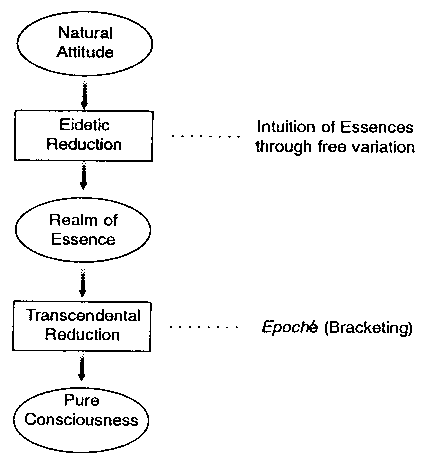
When we inquire into the general structure of pure consciousness, we find that it consists of Noesis, which is the intentional act, and Noema, which is the objective content the act refers. The relationship between them is as that between "to think" and "to be thought." In this way, phenomenology tries faithfully to describe pure consciousness.
8. Analytical Philosophy -- The Method of Linguistic Analysis
Analytical philosophy forms one of the mainstreams of' philosophy in the contemporary Western world.
Analytical philosophy is the position that generally considers that the main task of philosophy lies in the logical analysis of linguistic structures. This position can be divided into two schools, namely, logical positivism in the early period and the ordinary language school in the later period.
Logical positivism was formed centering around the philosophers of the Vienna Circle, namely, Moritz Schlick (1882-1936) and Rudolf Carnap (1891-1970). Logical positivism was influenced by "logical atomism," proposed by Bertrand Russell (1872-1970) and Ludwig Wittgenstein (1889-1951). According to logical atomism, the world is an agglomeration of atomic facts, which are the ultimate logical units. Logical positivism asserts that only the knowledge that is verified through empirical perception is correct knowledge and that all the studies of facts should be done by science. Thus, the task of philosophy is to make a logical analysis of language so as to eliminate the ambiguities of ordinary language expressions.
Renouncing conventional languages, they aimed at establishing one ideal, artificial language common to all sciences. This is the mathematical language employed by physics, or the language of physics. They sought to unify the sciences through this ideal language. The mottoes of logical positivism were anti-metaphysics, the analysis of language, and scientism.
Proponents of logical positivism did not realize, however, that even scientific knowledge is based on unverified propositions, and that the assertions of logical positivism themselves were a form of dogma; thus, the limitations of logical positivism became clear. Then, an ordinary language school, centering on George Edward Moore (1873-1958) and Gilbert Ryle (1900- ), came to be established.
The ordinary language school also holds that the task of philosophy is the logical analysis of language, but it abandoned the idea of forming a single, ideal, artificial language, and considered its task to be that of clarifying the meaning of concepts and discovering the logical structure within ordinary languages. Along with this, the anti-metaphysical attitude in analytical philosophy was eased considerably.
II. Unification Methodology - The Give-and-Receive Method
The methodology of Unification Thought is based on the Unification Principle, and is called Unification Methodology. This has also the meaning that it unifies traditional methodologies. The fundamental law of Unification methodology is the "method of give-and-receive action," which is simply called the "give-and-receive method."
A. Kinds of Give-and-Receive Action
Give-and-receive action refers to the interaction between subject and object, and this action has a center, which serves as (lie motive for this action. The nature of give-and-receive action is determined by the nature of the center. When give-and-receive action is carried out centering on Heart, subject and object become united, and the result of the give-and-receive action is a union. When a purpose is set up by Heart, however, arid give-and-receive action takes place centering on that purpose, a multiplied body, or a new-born body, is produced.
The four-position base in the Original Image is a notion dealing with the structure of God's attributes, which is the structure of four positions consisting of Heart (or purpose) as the center, subject, object, and a union (or a multiplied body). Seen from the viewpoint of time, Heart (or purpose), which is the center, exists first; then, with that as the starting point, the subject and the object enter into give-and-receive action; finally, a union or a multiplied body is formed. Here, Heart, which is the center, stands as Origin (Chung); the subject and the object stand as Division (Boon), in the sense that thy are separated and placed face-to-face with each other; and the union or the multiplied body, namely, a result, stands as Union (Hap). The whole process of this give-and receive action is called Origin-Division-Union Action (Chung-Boon-Hap Action) (Fig. 11-2).
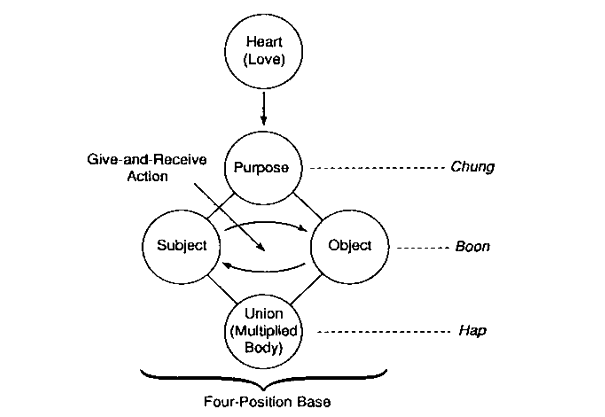
Division, in Origin-Division-Union Action, means not that the Origin is divided into two halves, but that the two elements are separated and placed face-to-face with each other, centering on the Origin.
Boon (Division) in God means the correlative attributes of the one God. Those two correlative attributes enter into give-and-receive action centering on Chung (Origin) and form flap (Union).
There are four kinds of give-and-receive action: identity-maintaining, developmental, inner, and outer give-and-receive actions. Corresponding to these, four kinds of four-position base are formed, namely, identity-maintaining, developmental, inner, and outer four-position bases.
1. Identity-maintaining and Developmental Give-and-Receive Actions
In God, there is the identity-maintaining, unchanging aspect, in which His Sungsang and Hyungsang engage in give-and-receive action centering on Heart, and He exists eternally as a unified being, or a union; also, there is the developmental aspect, in which His Sungsang and Hyungsang engage in give-and-receive action centering on purpose (Purpose of Creation) and produces a multiplied body, or a new-born body, namely, a created being.
The first form of give-and-receive action is identity-maintaining give-and-receive action; the second is developmental give-and-receive action. All beings in the created world also perform identity-maintaining and developmental give-and-receive actions, maintaining both unchanging and changing (developing) aspects.
The appearance of the universe is considered to be relatively and generally unchanging. The galaxy constantly maintains the same shape of a convex lens while revolving around the center of the universe. Within it, our solar system revolves around the center of the galaxy in a cycle of 250 million years, but is always located at the same distance from the center of the galaxy. Moreover, the disk shape of the solar system is also unchanging. The solar system has nine planets, each of which maintains its unchanged orbit while revolving around the sun.
Each planet maintains its definite characteristics. In this way, the universe has unchanging aspects.
Yet, when seen in terms of the long period of about fifteen billion years, the universe is also found to be developing and growing. Scientists explain this fact by saying that the universe expands, or evolves. The universe has changed from the wholly gaseous state to produce liquids and solids; and on the surface of the earth, plants, animals, and humans have appeared. This process of the universe can be regarded as a kind of process of growth. In this way, the universe has both the aspect of identity-maintenance and the aspect of development.
Living things, as well, develop while maintaining their identity. In plants, seeds sprout, trunks grow, leaves come out, flowers blossom and bear fruit; in this way, they grow constantly. Still, they continue to be the same plants. Particular kinds of plants continue to produce the same kinds of flowers, the same kinds of fruits, etc.
Likewise, animals develop and grow while maintaining their own identity.
The same can be said of human society. In the past, many states appeared, developed, and perished. Yet, the basic pattern of a state, in which sovereign and people are in the relationship of subject and object, remains identical in any state. In a family, family members grow constantly, but the relationships between parents and children, husband and wife, and so on, are unchanging. Individual persons also grow constantly while maintaining their own characteristics as individuals.
In this way, according to the law of give-and-receive, in every being, unchanging characteristics (identity-maintenance) arid changing characteristics (development) are united.
2. Inner and Outer Give-and-receive Actions
Within God's Sungsang (Original Sungsang), the Inner Sungsang and the Inner Hyungsang engage in give-and-receive action centering on Heart, forming a union. Through that, the inner four-position base is formed, which is the internal structure of God's Sungsang. Next, the Original Sungsang and the Original Hyungsang engage in external give-and-receive action, forming a union. At this point, it is the outer four-position base that is formed. When Purpose is established in Heart, the give-and-receive action assumes a dynamic, developmental nature. In the inner four-position base, Logos (conception) is formed as a multiplied body, and in the outer four-position base, created beings are formed as multiplied bodies.
This two-stage structure of inner and outer four-position bases in God is applied without change to the creation.
In the relationships between human being and all things (nature), through the inner give-and-receive action human being thinks and establishes conceptions (plans), while at the same time, through the outer give-and-receive action, human being cognizes and has dominion over all things. In human society, if we designate the give-and-receive action between the spirit mind and the physical mind within the human mind as the inner give-and-receive action, then the give-and-receive action between one person and another person (e.g., the give-and-receive action between husband and wife in a family) is the outer give-and-receive action. If we designate the exchanges among family members in a household as inner give-and-receive action, then the exchanges with other people in society become outer give-and-receive action.
Even a state has inner and outer give-and-receive actions. Within a state, the government and the people are engaged in the relationship of subject and object, and thereby politics and economy are carried out. This is inner give-and-receive action. At the same time, political and economic relations are formed with other states; this is outer give-and-receive action.
In the world of nature as well, there are inner and outer give-and-receive actions. In the solar system, inner give-and-receive action takes place between the sun and the planets; at the same time, the solar system is performing outer give-and-receive action with other stars. Also, if we designate the give-and-receive action within the earth the inner give-and-receive action, then the give-and-receive action between the sun and the earth is called outer give-and-receive action. In living things, inner give-and-receive action occurs between the nucleus and the cytoplasm in each cell, while cells perform outer give-and-receive action with one another.
In this way, in the relationships between human being and things, as well as in the relationships in human society and even in the creation, inner and outer give-and-receive actions take place in unity. As these inner and outer give-and-receive actions are carried out smoothly arid harmoniously, things maintain their existence and continue to develop.
Now let us consider the relationship between the deductive and the inductive method on one hand, and the Unification method on the other. Deductive method is the method of logical development through inner give-and-receive action that takes place within the human mind. In contrast, inductive method is the method of examining things in the external world-therefore, it is a method based on outer give-and-receive action. In Unification methodology, inner and outer give-and-receive actions take place in unity. Therefore, in Unification methodology, the inductive and the deductive methods are united.
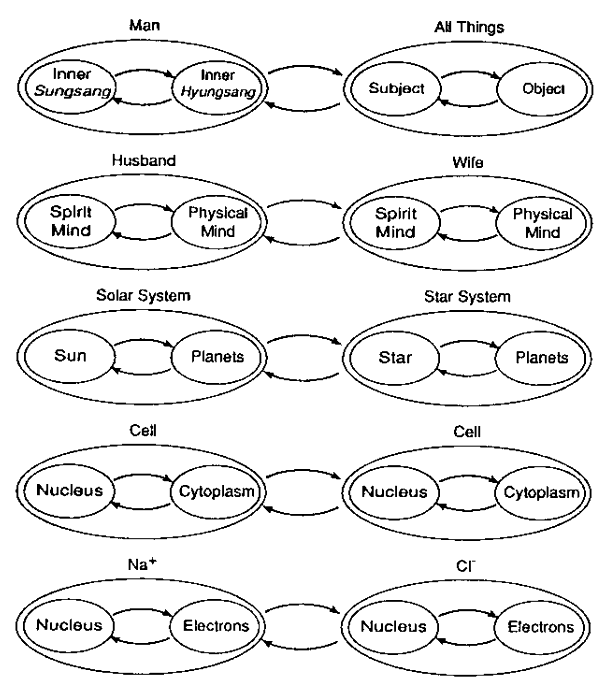
B. Scope of the Give-and-Receive Method
As explained above, in the give-and-receive actions there are inner and outer identity-maintaining give-and-receive actions and inner and outer developmental give-and-receive actions. As such, the give-and-receive method is the fundamental method for existence and development in God, human being and nature.
God, while maintaining His eternal nature through inner and outer identity-maintaining give-and-receive actions, created humankind and all things through inner and outer developmental give-and-receive actions.
In humankind and in all things, each individual (individual truth body) maintains its existence and develops as the correlative elements within it perform inner give-and-receive action, and at the same time perform outer give-and-receive action with other individuals.
Give-and-receive action between individuals includes give-and-receive action between a human being and another human being, between human being and things, and between a thing and another thing. First, there is give-and-receive action between one human being and another, which includes individual interaction in family life and in social life. Educational, ethical, political, economic, and other activities are carried out through this type of give-and-receive action.
Next is the give-and-receive action between human being and things. In this type of give-and-receive action, there are two cases, namely, the case in which human being exercises dominion over things, and the case in which human being cognizes things. The cognition of all things includes the basic study of natural sciences, the exploration and appreciation of nature, and so forth. Dominion over things includes applied research in natural sciences, business and economic activities, creative activities in art, and so forth.
Finally, there is the give-and-receive action between a thing and another. In nature, numerous individuals form an organic orderly world as they engage in give-and-receive actions through their respective positions-such as the give-and-receive action among atoms, among cells, and among stars. The interaction between the parts of a machine is another example of this case.
Thinking and conversation are also carried out according to the give-and-receive method. That is to say, when the subjective part in thinking (inner Sungsang), namely, the functions of intellect, emotion, and will, and the objective part (inner Hyungsang), namely, ideas, concepts, laws, mathematical principles, etc., enter into give-and-receive action, human thinking is conducted.
Judgment in thinking is also based on the give-and-receive method. In the judgment, "This flower is a rose," for example, contrast-type give-and-receive action takes place, in which one compares the idea "this flower" with the idea "rose." Conversation, also, follows the give-and-receive method. If one person talks nonsense, the other cannot understand what that person is saying, I can understand what another person is saying because the notions and concepts of that person are in accord with mine, and AM because the laws of thought and laws of conversation of the other person are in accord with mine.
C. Types of Give-and-Receive Actions
The give-and-receive method has the following five types of give-and-receive actions, which were explained in Ontology:
D. Characteristics of the Give-and-Receive Method
The give-and-receive method has the following seven characteristics which also were explained in Ontology:
III. An Appraisal of Conventional Methodologies from the Perspective of Unification Thought
A. Methodologies in the Ancient Period
1. Heraclitus
Heraclitus said that "everything is in a state of flux." It can be said that lie grasped only the developmental aspect in the created world, neglecting the identity-maintaining aspect. He also said, "War is the father of all," ascribing the cause of the development of things to the struggle of opposites. Yet, things develop only through the harmonious give-and-receive action between correlative elements.
2. Zeno
First, let us consider his theory that a flying arrow is at rest. When Zeno says that an arrow is at rest at a certain point, he is referring to a mathematical point, which has no space. The actual movement of an arrow occurs within time and space. The velocity of a body in motion (v) is the distance traveled (s) divided by the time elapsed (t), and is expressed with the equation v = s/t. Therefore, the movement of an object must be considered within a definite distance (space) and within a definite period of time. The movement of an object cannot be discussed at a point that only has position but no space (a mathematical point). Therefore, when we speak of the movement of an object at a certain point of space, no matter how small that point may be, we should consider it within a definite space, and when we speak of the movement at a certain moment, no matter how short that moment may be, we should consider it within a definite period of time. If we do so, we can say, definitely, that a moving object is not at rest, but rather moving through a certain point of space.
Concerning this issue, materialist dialectic asserts that an object is, and at the same time is not, at a certain place and at a certain moment, claiming that it has resolved Zeno's paradox and has explained motion. This, however, is no more than the same kind of sophistry as in Zeno's claim. The position of an object in motion is expressed as a function of time; therefore, to a certain moment corresponds a certain position on a one-to-one basis. It cannot happen that something is, and at the same time is not, at a certain place and at a certain moment.
In conclusion, (i) an object in motion passes through a certain space without resting in it; and (ii) an object in motion is at it certain place at certain moment of time.
The next issue is "Achilles and the tortoise." Zeno argued only in terms of space, disregarding time; therefore, the wrong conclusion was drawn that Achilles is unable to go ahead of the tortoise. If it is seen in terms of the passage of a certain time, Achilles can definitely go ahead of the tortoise.
Zeno tried to prove that there is no motion or change, there is no generation or destruction. To that end, he resorted to sophistry. It can be said that, contrary to Heraclitus, Zeno grasped only the identity-maintaining aspect of things, disregarding the developmental aspect.
3. Socrates
Socrates thought that people can reach the truth by means of a dialogue with a humble heart. This is the multiplication of truth through outer give-and-receive action between person and person. It can be said that Socrates advocated the proper way of give-and-receive action between person and person (Fig. 11-4).
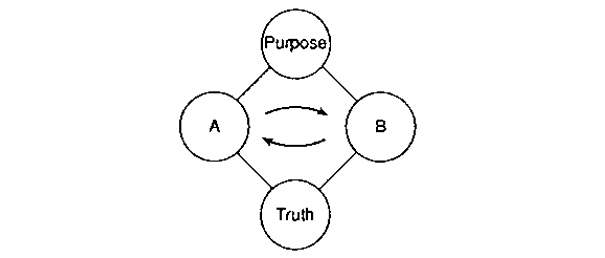
4. Plato
Plato studied the world of Ideas. In the human inner Hyungsang there are various concepts, and by analyzing and synthesizing them, Plato tried to clarify a hierarchy of Ideas. The analysis and synthesis of concepts are carried out through the comparison of concepts. This is a contrast-type of give-and-receive action. Since this is carried out within the mind, it is inner give-and-receive action. In the end, it can be said that Plato advocated the method of the search for truth through the contrast-type inner give-and-receive action (Fig. 11-5).
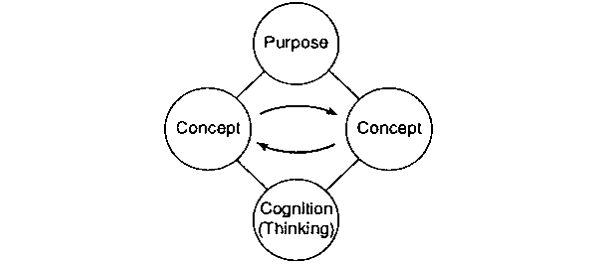
5. Aristotle
Aristotle's deductive method is based on the syllogism. First, an universal truth is proposed; then, a more limited truth is proposed; from those two, a specific conclusion is derived. In terms of the preceding example, one contrasts the major premise, "all men are mortal" with the minor premise, "Socrates is a man," and derives the conclusion, "Socrates is mortal." This is a contrast-type give-and-receive action between a proposition and a proposition.
Furthermore, since the proposition, "Socrates is a man" is obtained by contrasting "Socrates" and "man," this, also, is a contrast-type give-and-receive action.
Accordingly, Aristotle's deductive method, as in the case of Plato, can be called the method of the search for truth through the contrast-type inner give-and-receive action.
B. Methodologies in the Modern Period
1. Bacon
Bacon claimed that in order to obtain truth, one must cast away prejudices (Idols) and rely on experiment and observation. If the results of experiments A, B, C, ... N are all P, then conclusion P is established as a general law; this is the inductive method.
The inductive method seeks to obtain truth on the basis of outer give-and-receive action between human being and things (nature). Also, since this method yields a conclusion by contrasting various facts obtained through experiment and observation, it is give-and-receive action of the contrast-type. Therefore, Bacon's inductive method is the method of pursuing truth through contrast-type outer give-and-receive action (Fig. 11-6).
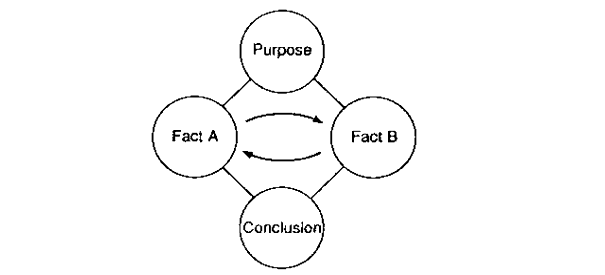
2. Descartes
Descartes attempted to doubt everything, and as a result, lie claimed to have reached a sure first principle: "I think, therefore I am." Here, the fact that Descartes doubted everything means that he denied every thing and phenomenon, and therefore, seen from the viewpoint of Unification Thought, he traced back to the stage prior to God's creation of the universe. Under that circumstance "I think" corresponds to God's "plan," or "thought," before His creation of the universe. Here, Descartes said, "I think; therefore I am"; but he should have asked "Why do I think?" If lie had asked that question, his rationalism would not have led to dogmatism in his successors. Anyway, his awareness of the truth of "I think; therefore, I am" means, from the viewpoint of Unification Thought, that lie acknowledged the certainty of the inner give-and-receive action within the human mind.
After that, he established a general rule that "things we conceive very clearly and very distinctly are true," which refers to the multiplication of truth through the formation of the inner four-position base (Fig. 11-7).
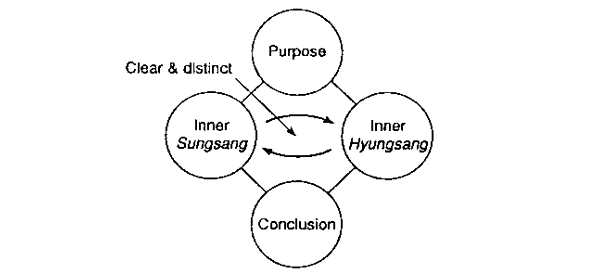
3. Hume
Hume considered causality merely a subjective belief. However, causality is not merely subjective, but is both subjective and objective, as already explained in the chapter on Epistemology. Moreover, Hume denied both material substance and spiritual substance (self), holding that there exist merely bundles of impressions and ideas.
From the perspective of' Unification Thought, lie saw only the inner Hyungsang (ideas) as sure things.
Hume tried to establish a complete system of philosophy by analyzing mental processes, but the problem was that he tried to do it on the basis of separate impressions and ideas.
4. Kant
Kant claimed that cognition takes place as the chaotic sensory content coming form the object are synthesized with a priori forms of the subject. Unification Thought agrees with the view that cognition occurs through the interaction between the human subject and the object. However, from the perspective of' Unification Thought, the subject possesses not only forms (forms of thought), but also content (images). The combination of form and content is called prototype. Also, what comes from the object is not chaotic sensory content, but content with forms of existence. Contrary to Kant's theory of synthesis, Unification Thought asserts the theory of collation. The Kantian theory of synthesis, which is based on the transcendental method can be regarded as an expression of tire Unification Thought theory of collation, which is based on the give-and-receive method, from Kant's position.
5. Hegel
Hegel grasped the development of the Idea and the word as the process of transcendence and the unity of contradiction -- or the process of thesis, antithesis, and synthesis. From the perspective of Unification Thought, however, development does not occur through contradiction. Development occurs when correlatives, in the relationship of subject and object, enter into give-and-receive action centering on purpose. (This is called Chung-Boon-flap Action.) In this, Chung means purpose, Boon means correlatives, and Hap means multiplied body.
The Idea does not develop by itself through the contradiction within, as Hegel claimed. Thinking is carried out as the inner Sungsang -- namely, the functions of intellect, emotion, and will-act upon the inner Hyungsang (including ideas), forming new ideas. This is called the development of thinking in a spiral form, as was explained in the chapter on Logic.
It can be seen that Hegel grasped development-which, according to Unification Thought, is give-and-receive action between correlatives-as interaction between opposing elements.
6. Marx
Marx held that spiritual processes are the reflection of material processes. From the perspective of Unification Thought, however, Sungsang (spirit) and Hyungsang (matter) are in the relationship of subject and object; therefore, there is a relationship of correspondence between spiritual laws (laws of value) and material laws.
As a counterproposal to the "law of the transformation of quantity into quality," Unification Thought offers the "law of balanced development of quality and quantity." From quantity to quality is not correct. Also, a sudden qualitative change does not occur when the quantitative changes reach a certain point. Quality and quantity are in the relationship of Sungsang and Hyungsang, and they change simultaneously, gradually, and stage by stage.
As a counterproposal to the "law of the unity and struggle of opposites," Unification Thought proposes the "law of the give-and-receive action between correlatives." The struggle of opposites gives rise only to destruction and ruin, and never brings about development. All things develop through the harmonious give-and-receive action between correlatives centered on a common purpose.
To the "law of negation of negation," Unification Thought proposes, as counterproposal, the "law of affirmative development." In nature, as well as in society, development takes place as the correlative elements of subject an(] object within nature and society perform harmonious give-and-receive action. In nature, inorganic beings perform circular motion in space and living beings perform circular motion in time (spiral motion).
Among the methodologies in the past, none was more influential than the Marxist materialist dialectic. Trying to prove that Marx's dialectic was valid in nature as well, Engels studied natural sciences for eight years. As a result, he concluded that "nature is the proof of dialectics." The errors of the materialistic dialectic are now evident, however. Natural phenomena are, if examined well, not the proof of dialectics, but instead the "proof of the give-and-receive method" (Fig. 11-8).
7. Husserl
Husserl first started with things of the natural world. Things are, when seen from the perspective of Unification Thought, the unified bodies of Sungsang and Hyungsang. Next, he advocated the intuition of essences through eidetic reduction.
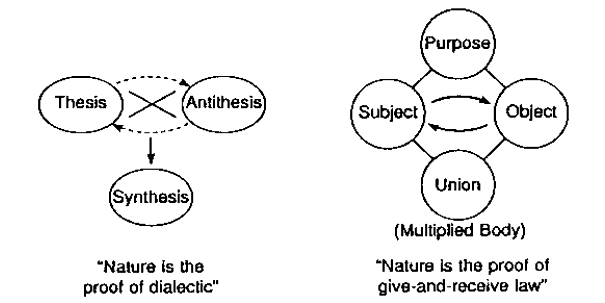
Fig. 11-8: Dialectic or Give-and-Receive Action
Essence here corresponds to the Sungsang of existing beings. In addition, Husserl claimed that when judgment is suspended and consciousness (pure consciousness) is analyzed, there is a structure of noesis and noema. This, when seen from the perspective of Unification Thought, corresponds to the internal structure of Sungsang (mind), which consists of inner-Sungsang and inner-Hyungsang. A comparison between Husserl's phenomenological method and the viewpoint of Unification Thought would be as in Fig. 11-9.
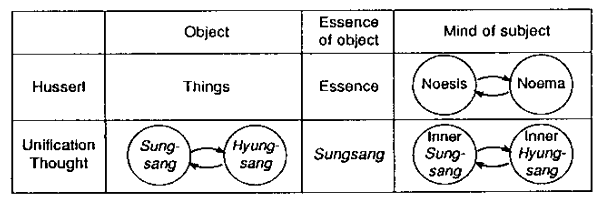
Husserl, like Descartes, considered, unconsciously, what corresponds to the Unification Thought concept of inner four-position base as important, and tried to unify all sciences through the analysis of the inner four-position base.
8. Analytical Philosophy
Language is formed through inner developmental give-and-receive action, which has an intellectual aspect (logos) centered on reason, and an emotional aspect (pathos) centered on emotional feelings. Analytical philosophy grasped only the aspect of logos, and pursued only logicalness.
From the perspective of Unification Thought, language, originally, exists in order to actualize love, and the logical structure of language is merely a necessary condition for that purpose. The use of language is the formation of thought, and is a kind of creative activity. The center of creative activity is Heart. Therefore, an emotional element centered on love plays the subjective role in the formation of thought. However, analytical philosophy engaged so much in the logical analysis of language from beginning to end that it came to disregard the creative aspect and the value-created aspect of thought formed through language.
Go Home to True Love
Go to the Contents Page
Go on to Notes.